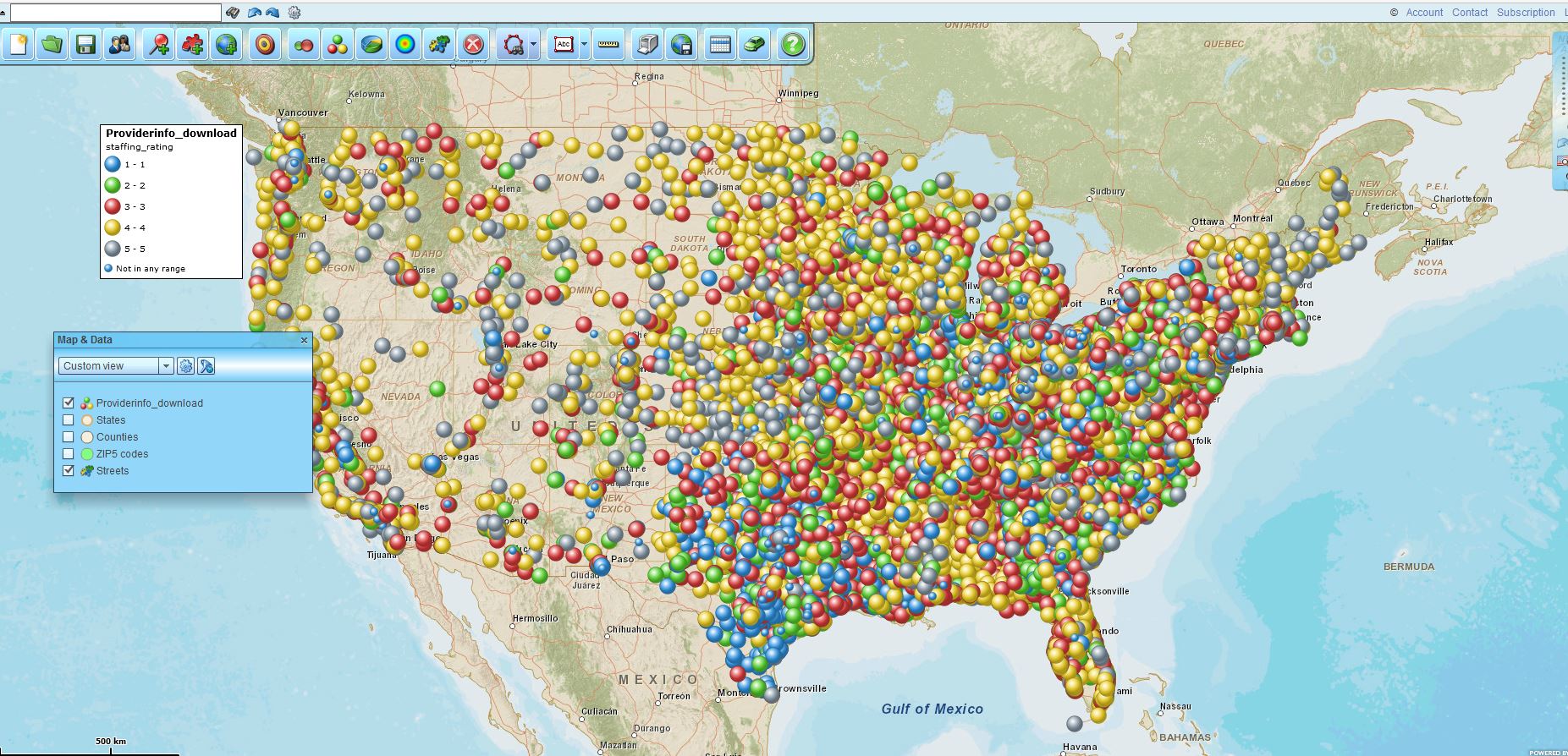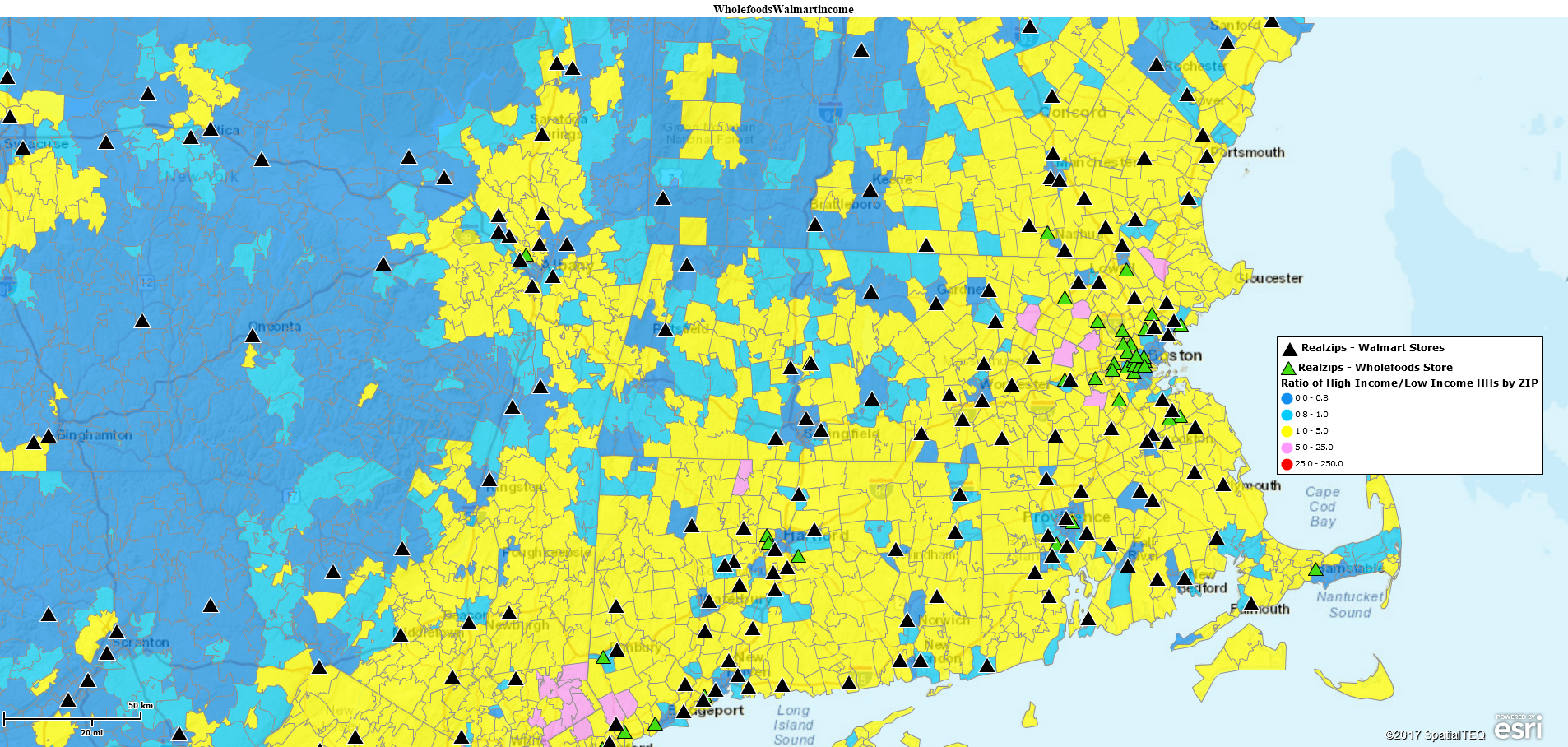Business map users often have an address-based dataset to import into their mapping applications. Sometimes these datasets have full addressing. At times, they have only a ZIP code associated with each record, or each point may be geolocated by latitude/longitude coordinates. MapBusinessOnline supports all of these location plotting options.
Suppose a MapBusinessOnline user imports an address-based dataset under Adding to Map. In that case, the Dataset process leads to map points representing all of the addresses in the imported dataset. Those points can then be color-coded by a column in the data, providing point differentiation on the map by classification.
Classification is a fancy way of saying by type. If, for instance, you imported a customer dataset with a column for Customer Type, then the color-coding process could color-code by customer type. Each customer type will display as a specific color point on the map. Bakeries might be green, Hardware Stores might be red, Hospitals might be blue, and so on.
Use the Symbols button under Color-coding on the Master Toolbar to color-code your imported data. Read more about color-coding points here.
MapBusinessOnline allows for up to 100 color variations for any imported list of points. So, if your dataset has less than 100 types, classifying all records by color is possible. If it has more than 100 types, you may need to split the data into multiple datasets.
However, before you go color-coding 99 points with slightly different shades of purple, let’s think this through. How do you think your map viewer will react to 99 shades of purple representing all your customers? In my experience, your map audience is not going to comprehend your map. Be careful about overwhelming the map viewer with too many color variations.
And what if you customer list is more numerous than 200 customers? How will you represent 500 or more customers on the map?
We recognize that there are times when the higher-ups in your organization insist that you color-code every record from a large spreadsheet. We advise you to proceed with caution because data color-coded with many colors can be confusing to business mapping software viewers.
Classify Your Customers
One way to solve this imported customer map point dilemma is to classify the customers by type. Here’s a more expansive list of possible customer types (keeping in mind your imported data could be something else besides customers):
- Automotive Tier II
- Big Box Store
- Brewery
- Bio-chem Laboratory
- Bakery
- Chemical Factory
- Dentist
- Franchise Business
- Manufacturer
- Medical Center
- Retailer
- Paper Company
- Plumbing Supply
- Variety Store
The possible list of customer/data types is endless, but usually, a company sells into less than ten markets. By classifying your customer data, you will organize your list while reducing the clutter on the map. All the points representing manufacturers will all be one color shade. For extremely large or critical customers, classify those customers uniquely by coloring them with a bright red or black color for fast identification.
MapBusinessOnline makes it easy to color-code up to 100 points by color. Try different classification schemes besides customer type. You could, for instance, classify your accounts by sales dollar ranges, sales rep, or the number of employees.
Also, the color-coding by Symbols process allows a map creator to Summarize your imported data by County, State, City, or ZIP code. Summarization is presented at step one of the the color-coding process. Summarization by map layer is another way to consolidate imported data. It’s worth a try if your imported data is large and concentrated in a particular region.
Import Territories Through Market Analysis Instead
While MapBusinessOnline limits the classification color-coding options to 100 color shades per dataset, the number of territories allowed per map is 1,000. So, where you could only apply 100 color classifications to an imported point layer, a user could import up to 1,000 territories per map.
One thousand territories are a lot of territories. A business map user rarely requires that many territories. But territories can solve the issue of displaying all customers on one map for any business requiring it. And it does happen. A territory solution will still be a busy map, but if the requirement is to show every customer on a list of more than 100 customers, territories may be the way to go.
While there may be actual territories defined for each customer by ZIP code, County, or City Limit, I suggest choosing a small radius, perhaps 1 mile, so each location gets a ZIP code territory. Here’s how it works:
Import the list of Customers using the MapBusinessOnline Market Analysis button option 1 – Search and Segment Data from Multiple Centers
- Select the Target Dataset of Customer addresses. Be sure to match the Name with the correct column in your data for name labeling.
- Choose Straight Distance as your Radius search option (1 mile.)
- Do not bother drawing circles around each location (the maximum allowable limit is 200 drawn objects.)
- Process page one by clicking Next in the lower right.
- On page two, select the ZIP code layer for Searching.
- Very Important – check on the Box at the bottom of the layer list that says Create Multiple Territories.
- Process by clicking Create in the lower right.
This process will create a set of ZIP codes territories instead of a list of points. Each territory will have a label.
This solution works best for lists of between 100 and 500 territories. It’s also most effective if the overall distribution of the customer locations is spread out nationally or over a relatively wide region. If, for example, you limit the search criteria for 500 records to the state of Massachusetts, the map will become too cluttered to be effective. Try it and see how it works. You can always delete the work.
In some cases, this means the boss’s desire to see every customer color-coded on the map is a bad idea from a mapping perspective. So, brace yourself. You know how very stable geniuses can be.
Once the territories by ZIP code are established, you can use the Color-code by Territory button in Map and Data to color-code each territory by a column within your data.
MapBusinessOnline provides options for color-coding points, territories, or map layer objects. Try the various options to decide what is the best solution for your business requirements.
Just make sure your map is understandable for your map audience. Because when the attendees at the meeting tell your boss the map makes no sense, who do you think will take the heat?
_______________________________________________
Find out why over 25,000 business users log into www.MapBusinessOnline.com for their business mapping software and advanced sales territory mapping solution. The best replacement for Microsoft MapPoint happens to be the most affordable.
To access MapBusinessOnline, please register and then download the Map App from the website – https://www.mapbusinessonline.com/App-Download.aspx.
After installing the Map App, the MapBusinessOnline launch button will be in the Windows’ Start Menu or Mac Application folder. Find the MapBusinessOnline folder in the Start Menu scrollbar. Click the folder’s dropdown arrow and choose the MapBusinessOnline option.
The Map App includes the Map Viewer app for free non-subscriber map sharing.
Please read customer reviews or review us at Capterra, or g2crowd
Contact: Geoffrey Ives geoffives@spatialteq.com or Jason Henderson jhenderson@spatialteq.com


